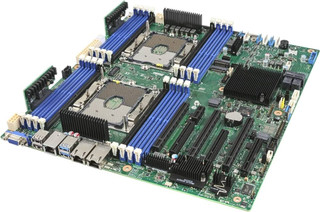Best Desktop Motherboards for Modern Computing

The desktop motherboard is the backbone of every personal computer, a crucial component that connects all other parts and ensures seamless operation. As part of both consumer and professional IT hardware setups, desktop motherboards have evolved significantly, becoming more powerful, compact, and versatile. In modern computer hardware systems, choosing the best desktop motherboards means balancing compatibility, performance, and future-proofing.
Understanding the Role of Motherboards in Computer Hardware
A motherboard is a printed circuit board (PCB) that houses and connects essential system components such as the CPU, RAM, GPU, and storage devices. In IT hardware, motherboards provide not just electrical connections, but also a framework for communication between devices. The best desktop motherboards enable optimal data throughput, overclocking capabilities, expansion options, and integrated connectivity features like Wi-Fi and Bluetooth.
Types of Desktop Motherboards
ATX Motherboards
One of the most common form factors in computer hardware, ATX motherboards offer extensive expansion options and high performance, making them ideal for gaming and workstation builds.
Micro-ATX Motherboards
Smaller than ATX, these are suitable for budget or compact builds while still offering decent performance.
Mini-ITX Motherboards
Designed for ultra-compact PCs, Mini-ITX boards are ideal for home theaters or portable gaming rigs, albeit with fewer expansion slots.
Key Features of the Best Desktop Motherboards
Chipset Compatibility
The chipset determines how well a motherboard can support CPU, RAM, and GPU configurations. Chipsets from Intel (Z790, B760) and AMD (X670, B650) dominate the IT hardware space.
Socket Type
Each CPU requires a specific socket. The best desktop motherboards align with current-generation CPUs, such as LGA1700 for Intel or AM5 for AMD.
Memory Support
Top-tier motherboards support DDR5 RAM and offer four or more DIMM slots with high-speed overclocking.
Expansion Slots
PCIe 5.0 slots are now common in high-end boards, useful for gaming and professional GPU installations.
Storage Options
Look for M.2 NVMe SSD support, SATA ports, and RAID configurations to maximize storage performance.
Integrated Features
Built-in Wi-Fi 6E, Bluetooth 5.2, and advanced audio chips are now standard in the best desktop motherboards.
Top Picks: Best Desktop Motherboards in 2025
1. ASUS ROG Maximus Z790 Hero
A premium choice with outstanding VRM, robust overclocking, and exceptional thermal management. Ideal for high-end computer hardware users.
2. MSI MEG X670E ACE
An AMD powerhouse with PCIe 5.0 support, DDR5 compatibility, and excellent aesthetics. Designed for enthusiasts.
3. Gigabyte Z790 AORUS Master
Well-balanced with top-tier networking and cooling. A popular choice in the IT hardware gaming segment.
4. ASRock B650M Pro RS
A budget-friendly AMD motherboard with surprisingly good features for its price point, including Gen 4 SSD support.
5. ASUS TUF Gaming B760M-Plus WiFi D4
Great value for mid-range gamers, offering solid build quality and modern connectivity.
Choosing the Right Motherboard for Your Needs
For Gamers
Look for boards with high overclocking potential, PCIe 5.0 slots, RGB lighting, and top-tier audio.
For Content Creators
Focus on multi-GPU support, fast RAM speeds, and abundant storage options.
For Business Users
Stable performance, virtualization support, and long-term reliability are key.
For Home Users
Affordability, ease of use, and basic connectivity features should guide your choice.
Compatibility with Other Computer Hardware
Your motherboard must be compatible with:
- CPU (Socket and Chipset)
- RAM (DDR4 or DDR5)
- GPU (PCIe Slot)
- Power Supply (ATX Power Connector)
- Case (Form Factor)
A mismatch can severely affect system performance or prevent booting.
Overclocking and BIOS Features
The best desktop motherboards come with intuitive BIOS interfaces that allow users to overclock CPUs and RAM easily. Features like XMP profiles, voltage regulation, and thermal monitoring are essential in modern IT hardware setups.
Future-Proofing Your Build
To ensure longevity in a fast-changing computer hardware environment, choose motherboards with:
- PCIe 5.0 compatibility
- DDR5 RAM support
- USB 4.0 and Thunderbolt ports
- BIOS Flashback and Q-Flash tools
These features ensure your system can adapt to upcoming components.
Troubleshooting Common Issues
Common motherboard-related problems include:
- POST errors
- No display signal
- RAM not recognized
These can often be resolved by updating BIOS, reseating components, or checking compatibility lists.
Conclusion: Making the Smart Choice
Choosing the best desktop motherboards is a foundational step in building or upgrading any PC. From gaming and content creation to business and home use, the right motherboard impacts performance, stability, and future upgrade paths. With continued advancements in IT hardware, staying informed ensures your system remains powerful, efficient, and ready for what’s next.
Whether you’re a professional assembling high-performance workstations or a casual user upgrading an old rig, the value of a reliable, feature-rich motherboard cannot be overstated in the ever-evolving world of computer hardware.




